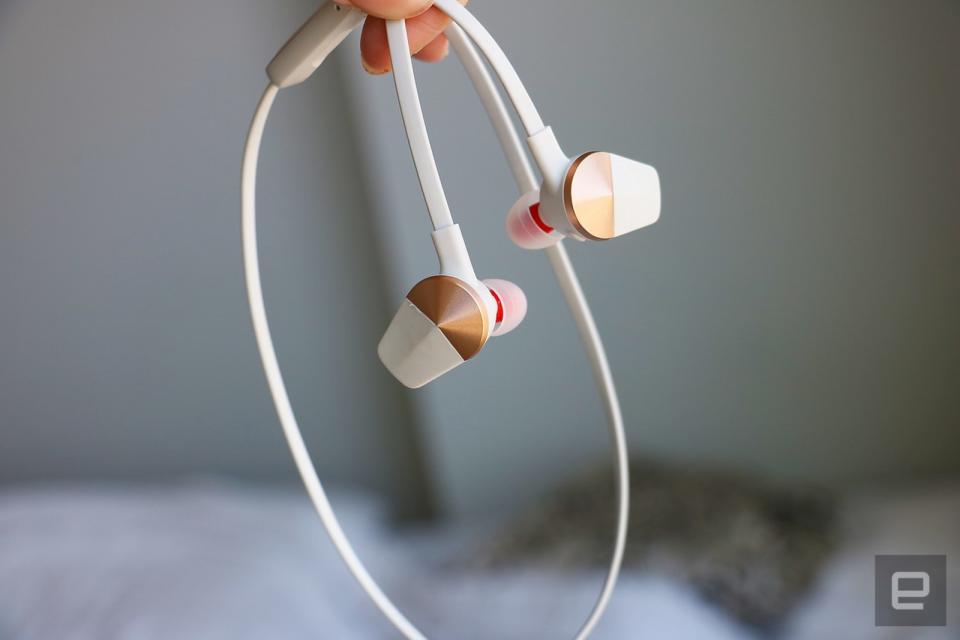Fitbit Flyer wireless headphones hands-on: Too basic for the price
No fancy sensors here.
Fitbit is coming for your ears. The company's first wireless fitness headphones, called Fitbit Flyer, are designed to accompany you on your workouts, thanks to a sweat-proof, durable body. I got to try out the Flyer, which we've seen leaked before, and am satisfied that it works as promised, but wish it did more or performed better.
The Flyer, at least, in gold-and-white, looks attractive and feels sturdy. A black-and-silver version is also available, and looks just as elegant. Its rubbery exterior is similar to that on many other sports-centric earbuds like the Jabra Sport Coach. I'm not a fan of the way in-ear buds in general poke into my ear, but the Flyer is relatively comfortable. Each pair of headphones comes with swappable tips, wings and fins so you can customize your device for a better fit. Many wireless earbuds already come with these add-ons, though.
To be clear, there is a cable connecting the Flyer's two buds. This isn't a completely wire-free product like the Bragi Dash Pro, Apple's AirPods or the Samsung Gear IconX. The Flyer's cable is long enough to encircle my neck, though, even with my thick hair in the way, and I liked letting the buds dangle down my chest as a sort of open necklace.

The device's power button is on the top of the right bud, and a thumb-length control box sits on that side of the cable. The box contains three buttons for you to adjust the volume or play, pause and skip tracks, which worked well during my testing, although they were somewhat hard to reach. You can also answer calls through the Flyer, which has a dual microphone to suppress noise for voice quality, although these aren't novel features either. I switched from my Apple earphones to the Flyer midway through a call, and my friend said she immediately noticed that I sounded clearer. On my side, I could hear sounds from my apartment, like the creak of furniture or my shuffling footsteps, more distinctly than before. This was frankly quite distracting.

The most appealing thing about the Flyer is how easily it connects to Fitbit's new Ionic smartwatch. All it took was a press of the headphone's power button and a tap on the watch's screen for the two to pair. Linking the Flyer with other devices, is trickier, though. The new headphones are supposed to simultaneously connect to two devices at once with Bluetooth 4.2, but you'll have to make sure the Ionic isn't in the vicinity or Fitbit's headphones will connect to it by default. You'll also have to shut down the headphones, then restart them in pairing mode before other devices can detect them. This is similar to the pairing process for most other Bluetooth earbuds, but made slightly more confusing by the Flyer's preference for the Ionic smartwatch.
The Flyer's most essential feature is the promise of "high-quality sound" with "crisp audio, powerful bass and dynamic range." I listened to a playlist of songs including Taylor Swift's Look What You Made Me Do, Camila Cabello's Havana and Macklemore's Glorious. The Flyer delivered thumping bass and crisp audio even at max volume, although I wished higher notes and vocals were stronger.
The device should, in theory, last up to six hours of playtime, and Fitbit says you can get an hour of juice with just 15 minutes of charging. That's less than the eight-hour rated runtime for the Jaybird X3, which is a popular option in the space, although it only plays music. But other than working seamlessly with the Ionic smartwatch, the Flyer doesn't do anything differently from other wireless headphones. Think about it, the Jabra Sport Coach can count your reps for you, and for $10 cheaper than the Flyer. For the $130/£110 asking price, you'll easily find a wide selection of competing (and more-established) brands like JBL, Bose, Jabra, Jaybird and Plantronics. If you're considering buying the Flyer, you'd do well to remember that playing music is really all it does, and that there are cheaper options that can do more or better.































